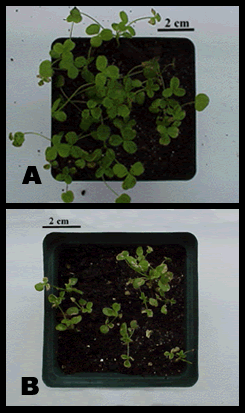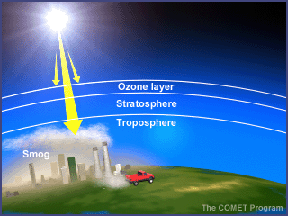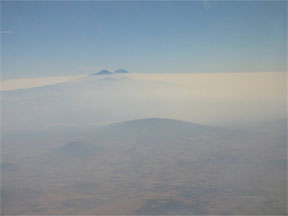
Greg Anderson, Bates College, Department of Biology
Air Pollution Affects Plants, Animals, and Environments
Air pollution does not only damage the air; it also damages environments on Earth’s surface and their inhabitants. Plants and animals are harmed by air pollution. Sometimes it is the pollutants themselves that cause damage. Other times pollutants combine and change the resources that plants and animals depend upon such as water, soil, and nutrients. Read on to learn more about the ways that air pollutants can damage environments and the living things within them.
Acid rain harms living things
When an air pollutant, such as sulfuric acid combines with the water droplets that make up clouds, the water droplets become acidic. When those droplets fall to the ground as rain or snow, the acidity of the water can have damaging effects on the environment. When acid rain falls over an area, it can kill trees and harm animals, fish, and other wildlife. Acid rain destroys the leaves of plants. When acid rain infiltrates into soils, it changes the chemistry of the soil making it unfit for many living things that rely on soil as a habitat or for nutrition. Acid rain also changes the chemistry of the lakes and streams that the rainwater flows into, harming fish and other aquatic life.
The thinning ozone layer harms living things
Air pollutants called chlorofluorocarbons(or CFCs) destroy ozone molecules in the stratosphere. This has left places in the layer where the ozone is thin. These areas of thin ozone are called ozone holes. The ozone layer, located in the stratosphere layer of Earth’s atmosphere, shields our planet from the Sun’s ultraviolet radiation. Ultraviolet radiation causes skin cancer and damages plants and wildlife. In recent decades the number of CFCs released into the atmosphere has decreased significantly due to an agreement between the nations of the world called the Montreal Protocol. Although it takes a long time to see the impact, the ozone holes might someday be smaller.
Tropospheric ozone harms living things
Ozone molecules in the troposphere damage lung tissues of animals and prevent plant respiration by blocking the openings in leaves, called stomata, where respiration occurs. Without sufficient respiration, a plant is not able to photosynthesize at a high rate and will not be able to grow. Ozone is also able to enter the stomata and decay plant cells directly.
Global warming harms living things
Our planet is currently warming much more rapidly than expected because of additional greenhouse gases that are released into the atmosphere from air pollution. When fuels are burned, some of the pollutants released, such as carbon dioxide, are greenhouses gases. Through the process of photosynthesis, plants convert carbon dioxide into oxygen and use the carbon to grow larger. However, the amount of carbon dioxide released by burning fuels is far greater than plants can convert. Cutting down forests exacerbates the problem.
Global warming is changing climate globally and is causing significant changes to various regions of the world. For example:
- Polar ice melt and permafrost melt are causing changes in the habitat and resources for plants and animals living in polar ecosystems.
- Ocean warming, rising sea levels, increasing runoff, and coral diseases are causing change in shallow marine ecosystems such as coral reefs.
- Less rainfall in the dry interiors of continents due to global warming is limiting water resources for plants and animals.














